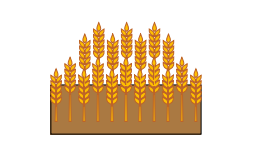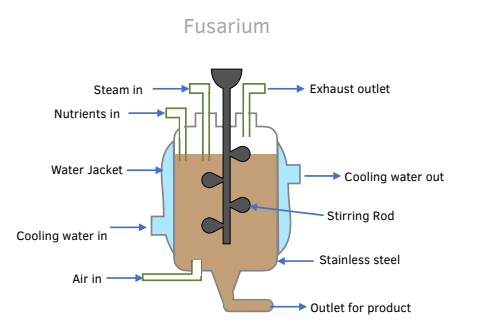4.7.5 Food production (biology only)
4.7.5.1 Factors affecting food security
Food Security and Population Growth
- We have already discussed how the population is growing at an alarmingly high rate.
- One of the problems that can develop due to this is a lack of food security.
- Many areas of the world now have a great shortage of food.
- This is known as a famine.
Food Security: A Case Study
- Ethiopia, once one of the world’s richest countries, suffered ahorrible famine in the 1980s.
- This led affected hundreds of thousands of people.
Basic Definition
- Food security is defined as having enough food to feed a population.
Biological Factors
- Population Increase
As birth rates increase and health care improves, the population will increase. This leads to a greater demand for food. This can threaten food security.
- Changing Diets
As diets have changed around the world, people no longer eat the food that is found in their region and have began to rely on importing food. This means that some of the most scarce resources are spread around.
- Pests and Pathogens
New pests and pathogens have developed that crops and animals are no longer immune to. This threatens food security. An example of this is the H1N1 swine flu that gripped the world in 2009.
- Environmental Changes
As the environment changes, there is increased rainfall and increased droughts in different places. This can lead to crop failures, threatening the food security.
- Increased Costs of Agriculture
As land becomes more and more expensive and crops become cheaper, farmers are moving professions in search of greener pastures. This threatens food security.
- Conflict
War and conflicts in areas can threaten the supplies of food and water. The annexation of Crimea for example, has led to a massive shortage of water in this region.
Sustainability
- As people must be fed, sustainable methods are required.
- Golden rice was considered a great way of feeding those with Vitamin deficiencies.
- Now more and more time is being spent researching sustainable methods of food production.
4.7.5.2 Farming techniques
Farming and Modernity
- Modern day farming has changed the game.
- Whereas previously, food was farmed for a small area, maybe even one for a single family, now farmers make money by mass producing crops.
- Their techniques have changed for this.

Farming Intensively
- The key concept of intensive farming is that you put in a lot of energy in order to maximise crop yield.

Monoculture
- Monoculture is growing only one type of crop and maximising conditions to get the greater yield of this crop.
- This does have problems however, as it leads to a reduction in biodiversity as soil nutrients can be reduced.

Livestock Raising
- By reducing the energy output of livestock, their size and yield increases.
- This is done by keeping the animals in cramped conditions to restrict movement and regulating the temperature, to reduce any heat loss.
- They are also fed specific protein rich feed in order to increase their mass and reduce their waste.
- They are also given antibiotics to reduce any chance of illness.
Livestock Raising

Concerns

- Many people believe that the way livestock are treated is unethical, so there has been a great increase in free range animals.
- There are also concerns regarding the antibiotics that are given to animals, as they could be leading to an increase in antibiotic resistance.
- Moreover, monoculture has led to a reduction in biodiversity.
Farming Techniques

- Organic farming does not use any chemicals and instead relies on natural fertilisers like manure and compost.
- Crop rotation is a key concept in organic farming.
- This is the process of farming that involves changing the crops grown in a field over different periods.
- This avoids monoculture and increases species diversity.

4.7.5.3 Sustainable fisheries
Fishing
- Fish have been a part of the human diet for years upon years.
- Societies have survived upon fishing.
- Our impact on the world has now led to huge reductions in the fish stocks in the sea as biodiversity decreases.
- We have overfished during periods, which has led to a dramatic reduction in the population of many fish such as cod.

- We must make sure that fish stocks stay at a high enough level to that they can continue to breed or we may eventually lose species.
- The EU and other governments in the world have worked to reduce this by introducing fishing quotas.

Fishing Quota
- The EU has implemented TACs which are Total Allowable Catches.
- These are quotas set by the EU regarding the fish stocks that can fished.
- They are changed every two years dependent on the stocks of fish.
- This helps to maintain fish stocks at a sustainable level.
- Fish nets have been made larger, in order to catch only large adult fish.
- This means that young fish can grow and reproduce, in order to maintain biodiversity.

4.7.5.4 Role of biotechnology
Biotechnology
- Biotechnology is harnessing technology to develop and alter living organisms.
- It is used to suit the demands of our growing population.
- Cloning and genetic modification are examples of biotechnology.

Transgenic Organisms
- We have already discussed how genes are inserted into other organisms.
- An organism with that has the DNA of another organism inserted into it is known as a transgenic organism.

Transgenic Organisms
- As discussed in earlier tutorials, insulin is made from a genetically modified organism.
- Transgenic E Coli has been used to make it.
- The insulin then has to be purified for human consumption.

Fusarium
- The fungus Fusarium is genetically modified to produce a high in protein supplement food for vegetarians.
- This is grown in a fermenter.
- The conditions are kept at the optimum.
- Glucose syrup is added as food and the mixture is agitated by paddles to allow the optimum growth.
- The food then grows and is harvested.

Golden Rice
- In an earlier tutorial we saw the example of Golden Rice.
- Now, we can say that it is a GMO.

Other Uses
- Crops can be made that are resistant to insects and pesticides.
- This increases yield greatly.








Still got a question? Leave a comment
Leave a comment